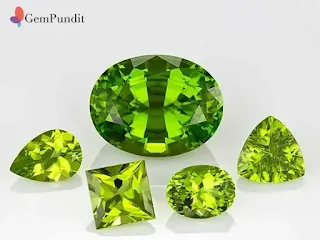What is Peridot?
Peridot gemstone is a member of the Olivine crystal family and hails from the forsterite-fayalite mineral group. It is one of the gemstones that is found in only one color; however, the hue of green may differ from light yellowish to dark brownish green. Peridot possesses to be the birthstone for the month of August as well.
The peridot is a beautiful, vibrant green gemstone that has been prized by humans since ancient times. This gemstone is found in only a few places on Earth, and its unique color is created by the presence of iron in the mineral composition. Natural Peridot Stone can range in size from very small stones to large crystals weighing hundreds of carats. The largest cut peridot is over 200 carats and is on display at the Smithsonian Museum in Washington, D.C.
History of Peridot
The peridot gemstone has a long and complicated history. It was first discovered on the island of Zabargad, which is now part of Egypt. The ancient Egyptians were the first to start mining these unique green gems. Ancient Egypt used green peridot gemstones for various purposes, including adornments for their Pharaohs and as burial gifts for their loved ones. This tradition continued for centuries, and peridot eventually became known as the "gem of the sun."
Types of Peridot in Terms of Color Variance
Peridot stones are considered one of the only stones available in a single color. They are found in different shades and hues, but the color will always be green and sometimes also called Evening Emerald due to its beautiful color when seen during sunset.
Most peridot gems have a green to yellowish green color. The intensity of the color depends on how much iron is present in the crystal structure. Peridots with a higher iron content will have a darker green color, while those with less iron will be lighter in color or even yellowish green (lime green). Some peridots may also have a brownish hue due to trace amounts of other elements in their crystal structure.
Yellowish-Green Peridot: Peridot with a more yellowish tint is sometimes called "chrysolite." This hue may lean towards a more lemony or chartreuse shade.
Olive Green Peridot: This is the most common color of peridot, displaying a rich olive or grass-green hue. Peridots in this range are often highly valued for their vibrant color.
Brownish-Green Peridot: Peridot with a brownish undertone is less desirable than those with a purer green color. However, some individuals may appreciate the earthier tones of brownish-green peridot.
Intense Green Peridot: Peridots with intense, vivid green colors are highly sought after and tend to be more valuable. These gems display a bright and lively green hue without significant yellow or brown undertones.
Olive-Yellow Peridot: Some peridots may exhibit a mix of olive green and yellow tones, resulting in a unique and distinctive coloration that can vary in intensity.
Where can you find Peridot?
Peridot, the gem-quality form of Olivine, can be found in various locations worldwide. Notable deposits include the San Carlos Apache Reservation in Arizona, USA, the island of Zabargad in Egypt's Red Sea, and the Mogok region of Myanmar. Other sources include Pakistan, China, Norway, Vietnam, and Australia, among others.
Is there Synthetic Peridot?
Synthetic peridot, created in laboratories through methods like flame fusion or hydrothermal processes, mirrors the chemical composition and crystalline structure of natural peridot. Offering affordability and consistency, it's utilized extensively in jewelry making and scientific research. While lacking the rarity of its natural counterpart, synthetic peridot provides an accessible alternative for various applications.
Tags:
Peridot









